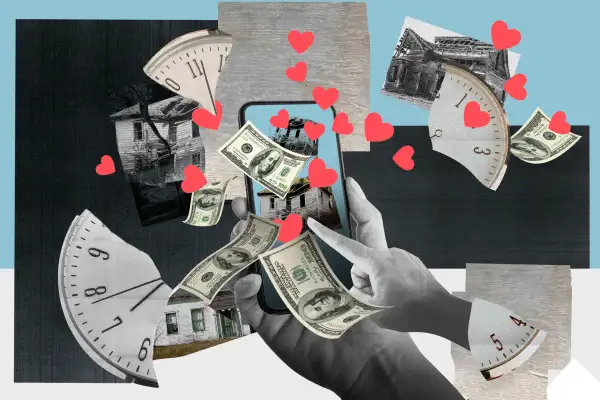'Cheap Old Houses' Are All Over Instagram. But Are They Good Investments?

There are two overwhelmingly sad truths about the majority of houses bought and sold in America right now. They are expensive, and they are mundane.
Scroll through enough Zillow listings for whatever part of the country you happen to live in and, eventually, all the laminate flooring and fake copper backsplashes will blur into an antiseptic haze.
If any pique your interest enough to make an offer, you’ll compete with an average of 4.8 other prospective owners, many with offers well over the asking price. And if you’re lucky enough to win a house, you’ll pay handsomely: As of April 2022, the median home sale price in the U.S. stood at $375,300, a record high, according to the National Association of Realtors.
It makes sense, then, why someone like Randi Howell would be drawn to something different.
Randi, 40, and her now-husband, Dave, 38, were about to be priced out of their Denver rental when she came across a crumbling, 6,000-square-foot mansion on the website Circa Old Houses. Located in rural Illinois, the home had acreage, charm and 150-plus years of history that was in danger of demolition or complete decay if someone didn’t swoop in and save it. It also had a name: Duncan Manor, after the cattle breeder who built it in the mid-1800s.
As luck would have it, the couple happened to be in Illinois for a wedding a few weeks later and decided to take a spur-of-the-moment drive down the stretch of historic Route 66 that runs by Duncan Manor. Shortly after that, they bought it for $149,000, uprooted their lives in Denver and moved in.
“It was a whirlwind,” Randi says. “And it has been ever since.”
The Howells belong to a small, but passionate group of people opting out of the modern housing market — and the high price tags that plague it — in favor of homes from centuries past that need a little love to make it to the next one.
Listings for these houses can be found in all the usual places — Zillow, Redfin, Realtor.com — but they tend to gain the most attention on highly-curated Instagram and Facebook pages like Cheap Old Houses (an offshoot of Circa Old Houses), Old Houses Under $50,000 and Vintage Houses for Sale.
This corner of the internet has been around for about a decade. And in the early days of COVID-19, headlines noted an upswing in its influence, highlighting the lockdown-induced cabin fever that drove city dwellers to relocate to massive DIY projects in upstate New York and the Midwest.
Less talked about, though, is what becomes of properties like these after the closing table. Are they fully restored or barely livable? A pandemic-era refuge or a bonafide headache? A worthwhile investment or The Money Pit?
For the Howells, who moved into Duncan Manor in 2014 and are still working on fixing it up eight years later, the answer is: all of the above.
House hunting? Check out Money's Best Places to Live
An alternative path to homeownership
If you love the old and ornate — clawfoot tubs, avocado green appliances, built-in bookcases — “old home” social media is one the best distractions the internet has to offer.
Across Facebook and Instagram, there’s a treasure trove of accounts featuring aging, on-the-market, properties: For the Love of Old Houses, Love of Houses, Old House Calling, Old House Dreams. On Reddit, there’s r/OldHouses, r/CenturyHomes, r/MidCenturyHomes … the list goes on.
Hands-down the most popular of the bunch — and the locus of many prospective homebuyers’ “the grass is always greener out of Victorian-era windows” reverie — is Cheap Old Houses. Its Instagram page has 2 million followers, and that’s just the main account — newsletter subscribers get access to offshoots like Cheap Old Farmhouses and Cheap Old Houses Abroad. Last year, curators Elizabeth and Ethan Finkelstein even got their own HGTV show.
The Finkelsteins, a married couple in New York, post historical homes with asking prices that usually fall between $80,000 to $120,000, though some are listed for $0 (provided the buyer can find a way to physically move them).
Given the sky-high barrier to entry for new homeowners — think about how hard it is to find a place for under $200,000 these days in virtually any census-designated place with a middle school and a post office — and it’s easy to see the appeal.
Over 100 families have purchased homes they found via Cheap Old Houses, Elizabeth says, many during the throes of COVID-19. We may now be in the waning days of the pandemic (praise be), but thanks to employers who have embraced remote work nationwide, many Americans are still living vastly different lives, in vastly different places, than they were two and a half years ago. And so, Elizabeth says, “People are still buying these houses.”
“It feels like a complete pipe dream, buying cheap and not killing yourself on the closing costs,” she says. “It’s been interesting to see people who are suddenly able to invest in homes who wouldn’t have had a prayer otherwise.”
The process of buying and restoring an old house flies in the face of how most people become homeowners: Instead of sinking your savings into a downpayment on a mortgage that can take the better part of a lifetime to pay off, you get a bargain price for a house and slowly make repairs to it as your budget allows. If you’re lucky (and handy) you might be able to make some of those repairs yourself.
In the Howells’ case, it helps that Dave has a degree in construction management, and the skills required to make an old home livable again. Another blessing: Most of the major restoration was done pre-pandemic, before the cost of construction materials like concrete and paint skyrocketed to record highs.
When the Howells relocated to Duncan Manor, it didn’t have working electricity, plumbing or heating. So for the first few months, their bathroom consisted of a solar-powered camp shower and “a five-gallon bucket with a snap on the lid for a toilet,” Randi says. A utility sink in the basement served as their makeshift dish-washing station, and since the house was too hot to sleep in, a balcony was their bedroom.
Duncan Manor’s previous owner, they’ve since learned, went bankrupt trying to restore it.
“It took us a good year to get it ‘livable’ by most people’s standards,” says Randi, who estimates they’ve spent $150,000 on renovations so far. “[But] “it worked because we went slow.”
Money pit or the secret to an affordable home?
Compared to a new home, is a “cheap old house” actually … affordable?
If you’ve watched five minutes of practically any HGTV show, you know that “staying on budget” during a home renovation is a moving goalpost, at best. This is doubly true for owners who want to maintain the historical fabric of an aging home. Vintage materials are especially hard to source and price compare, and it’s impossible to fully know the magnitude of the renovations required until they actually start tearing down walls.
Take Jenn Coomer, a 33-year-old digital marketing manager who’s currently rehabbing a 1790 home in Halifax, North Carolina. The property had been vacant for decades, “basically condemned” when she saw it on multiple social media pages in 2019, but Coomer says she “fell in love immediately.” So she flew to North Carolina without telling her husband and bought it for $11,000.
Coomer and her husband, Brandon, 38, have already successfully renovated two fixer-uppers in Florida — one they sold, and one they rent out as an Airbnb. Even so, a massive amount of time, money and “sweat equity” have gone into making their new house habitable, she says. To date, they’ve spent about $80,000 on foundation, chimney and roof fixes. When all is said and done, and the home is properly restored to “the showpiece it once was,” Coomer estimates that figure will be close to $225,000 — which she says is still less than the market value of the home.
At the beginning of May, the Coomers — Jennifer and Brandon, their two-year-old son, dog and two cats — moved into a 200-square-foot tiny home in Halifax, where they’ll live until the renovations are complete. Eventually, they plan on turning the house into a vacation rental and event space (the couple held their wedding on the property last spring).
“This was a massive project to take on,” Coomer admits. But because she bought the house for next to nothing, and the couple has been able to pay for renovations piecemeal with Airbnb earnings and cash they made from the sale of their first property, they haven’t had to take on any debt for the project.
Renovating old homes takes patience — and money — but for the people who buy them that's part of the appeal. The “cheap” asking price might get someone’s foot in the door, but the “old” — the creaky floorboards, the sweeping staircases, the dusty millwork — is what convinces them to buy. This home has been around a lot longer than we have, they say, and with any luck, it’ll still be here when we’re gone. They see themselves as temporary stewards, guiding these homes into a new era.
Hallie Gilman, 49, who’s in the midst of renovating a “derelict old farmhouse” in northern Maine with her husband, Ned, 48, says (sort of jokingly, sort of not) that when they first visited the property, it felt like they were meeting a troubled boyfriend for the first time. (“It needed us.”)
When they toured the house in late 2019, it didn’t have electricity, a reliable heat source or a kitchen stove. (It did, for whatever reason, have piles of antique lunch boxes and a stack of deer antlers the previous owner had apparently collected). The couple bought it for $85,000, with a dream of turning it into a vacation home, and when COVID-19 lockdowns reached their area, they threw themselves into making that dream come to fruition.
So far, it has not.
“The order of operations is something we’ve blown in 16 different ways,” Hallie says, adding that she recently spent two full days installing very pretty and very tedious cane webbing on the kitchen cabinets only to find out afterward that, due to structural issues, those cabinets are likely going to have to get ripped out.
It’s been a slow, unbudgeted burn. “We are literally just picking away, going room by room,” she says, but Hallie and her husband are determined to see the renovations through. “I can’t imagine who else will,” she says.
More from Money:
'Stressed and Alone': Homebuyers Are Turning to Therapy to Cope With a Wild Housing Market
Working From Anywhere? These Tips Will Help You Avoid Tax Nightmares
Why Investors Are Scooping up So Much Real Estate — and How Regular Homebuyers Can Compete

